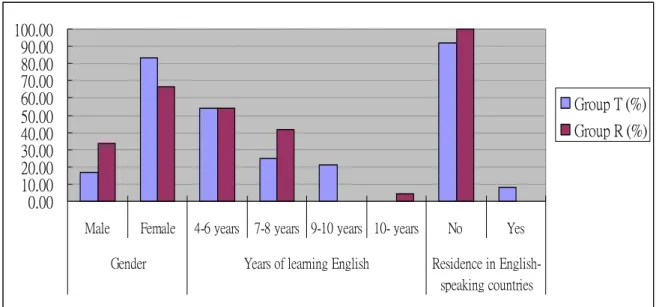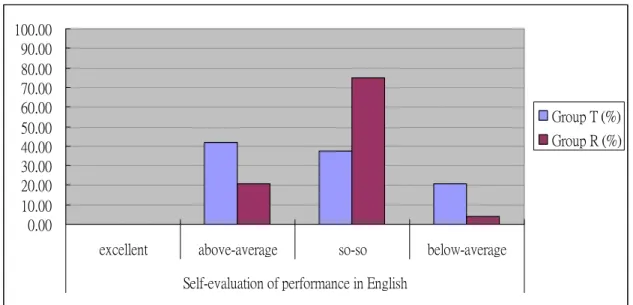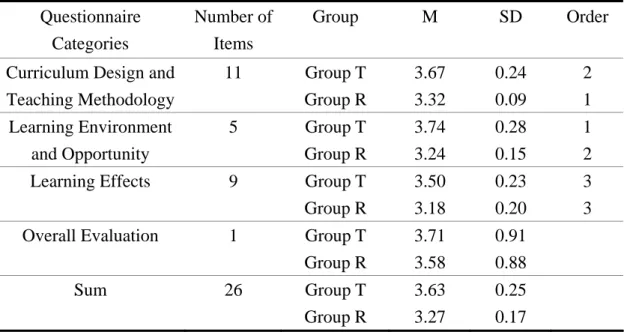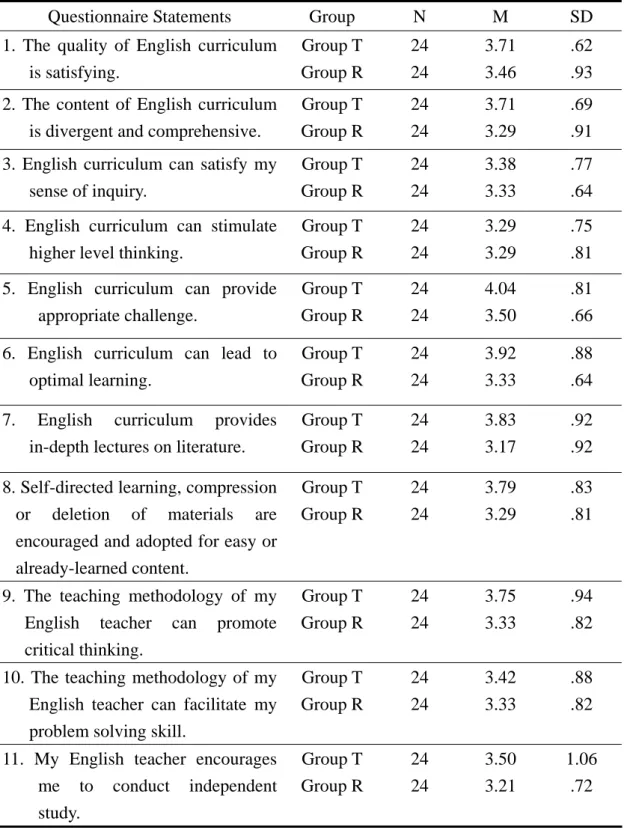CHAPTER FOUR RESULTS
The chapter aims to present the results of the study. It comprises five parts.
The first part provides the background information of the participants. The second part demonstrates the effects of English-talented program on the participants’ listening and reading comprehension. The third part reveals the effects of the talented program on the participants’ speaking and writing proficiency. The forth part shows the results of the evaluation questionnaire about the participants’ satisfaction levels towards the program provided. The last part presents the results of the semi-structured interview with nine students in the talented program.
A total of 48 students participated in the study and answered the evaluation questionnaire. Half of them were from the talented class and were labeled as Group T, while the other half of them came from regular classes and were classified as Group R. Nine students from Group T also received interview after their completion of the evaluation questionnaire.
Participants’ Background
The participants’ gender, years of learning English, and residence in
English-speaking countries were obtained from the evaluation questionnaire and are
shown in Figure 2. More female students (83.33% in Group T and 66.67% in Group
R) than male ones participated in this study. As for the number of years of learning
English, over half of the participants had been learning English for four to six years
(54.17% in Group T and 54.17% in Group R), which meant most students started
learning English since they were 5
thor 6
thgraders in elementary school. As for the
0.00 10.00 20.00 30.00 40.00 50.00 60.00 70.00 80.00 90.00 100.00
Male Female 4-6 years 7-8 years 9-10 years 10- years No Yes Gender Years of learning English Residence in English-
speaking countries
Group T (%) Group R (%)
rest of them: ten students in Group R (41.67%) had been learning English for seven to eight years and another student in this group had learned English for more than ten years; students in Group T, however, spread evenly between the spans of seven to eight years (25%) and nine to ten years (20.83%). Finally, when asked if they had the experience of residing in English-speaking countries, most answers of the participants were negative (91.67% in Group T and 100% in Group R). Only two participants from Group T expressed their short-term residence in English-speaking countries. One of them had a one-year stay in Australia when she was 14 years old, and the other one had lived in the United States for four months when she was about the age of 12.
Effects of English-talented Program on Listening and Reading Comprehension This part focuses on the effects of English-talented program on the participants’
receptive English abilities, namely their listening and reading comprehension. It is noted that students in both groups received educational training in the two aspects.
Figure 2. Background Information of the Participants
Effects on Listening Comprehension
Table 4 provides descriptive statistics of participants’ performance of the pretest and posttest on listening comprehension. Group T (M = 30.92, SD = 2.70) obtained higher mean and smaller standard deviation than Group R (M = 27.42, SD = 3.57) in the pretest. After five months, both groups improved on their English listening comprehension but also had larger standard deviations in the posttest: Group T ascended to 33.67 (SD = 3.32), while Group R rose to 29.00 (SD = 4.14).
Table 1. Descriptive Statistics of the Pretest and the Posttest on Listening Comprehension
Group N Pretest Posttest
Group T
24 M = 30.92
(SD = 2.70)
M = 33.67 (SD = 3.32) Group R
24 M = 27.42
(SD = 3.57)
M = 29.00 (SD = 4.14)
Analysis of covariance (ANCOVA) was used in the comparisons across groups to explore whether the use of differentiated curriculum had a positive effect on the English-talented students’ listening comprehension. An ANCOVA analysis shows that there was a significant difference, F (1, 45) = 4.66, p = .036, between groups in the posttest (see Table 5). It means Group T outperformed Group R on listening comprehension after the use of differentiated curriculum.
Table 2. ANCOVA Summary for Listening Comprehension
Source SS df MS F p
Covariate (pretest) 236.36 1 236.36 25.88 .000
Group 42.56 1 42.55 4.66* .036
Error 410.97 45 9.13
Note.
Homogeneity of regression was examined before ANCOVA analysis. * p < .05. ** p< .01. *** p < .001. The adjusted mean for Group T was 32.42, whereas that for Group R was 30.25.
Effects on Reading Comprehension
Descriptive statistics of participants’ performance of the pretest and posttest on reading comprehension are shown in Table 6. Group T (M = 26.79, SD = 3.72) had higher mean and also larger standard deviation than Group R (M = 22.96, SD = 2.54) in the pretest. After the five-month treatment, both groups improved on their English reading comprehension in the posttest: Group T climbed up to 27.38, while Group R moved up to 24.21. However, participants in Group R (SD = 5.66) showed even larger standard deviations than Group T (SD = 3.89) in the posttest.
Table 3. Descriptive Statistics of the Pretest and the Posttest on Reading Comprehension
Group N Pretest Posttest
Group T
24 M = 26.79
(SD = 3.72)
M = 27.38 (SD = 3.89) Group R
24 M = 22.96
(SD = 2.54)
M = 24.21 (SD = 5.66)
As shown by the result of an ANCOVA analysis in Table 7, there was a
significant difference, F (1, 45) = 6.59, p = .014, between groups in the posttest. It
means that Group T outperformed Group R on listening comprehension, which
suggests that the use of differentiated curriculum had a positive effect on the
English-talented students’ reading comprehension.
Table 4. ANCOVA Summary for Reading Comprehension
Source SS df MS F p
Covariate (pretest) 33.96 1 33.96 1.46 .234
Group 153.68 1 153.68 6.59* .014
Error 1049.63 45 23.33
Note.
Homogeneity of regression was examined before ANCOVA analysis. * p < .05. ** p< .01. *** p < .001. The adjusted mean for Group T was 27.89, whereas that for Group R was 23.69.
Effects of English-talented Program on Speaking and Writing Ability
This part centers upon the effects of English-talented program on the participants’ productive English abilities, that is their speaking ability as well as writing ability (The latter ability also includes the participants’ translation ability and composition ability). It is worth mentioning that only students in Group T received special training in these two areas.
Effects on Speaking Ability
Table 8 offers descriptive statistics of participants’ performance of the pretest and posttest on speaking ability. In the pretest, Group T (M = 77.50, SD = 8.23) got higher mean and also larger standard deviation than Group R (M = 71.54, SD = 6.26).
After the use of differentiated curriculum, participants in Group T (M = 84.60, SD =
3.87) made great progress on their English speaking proficiency in the posttest,
whereas participants in Group R (M = 71.67, SD = 6.39), who received no training in
this area, showed little change in their English speaking ability.
Table 5. Descriptive Statistics of the Pretest and the Posttest on Speaking Ability
Group N Pretest Posttest
Group T
24 M = 77.50
(SD = 8.23)
M = 84.60 (SD = 3.87) Group R
24 M = 71.54
(SD = 6.26)
M = 71.67 (SD = 6.39)
As Table 9 shows, there was a significant difference between groups in the posttest in English speaking ability, p < .001. Actually, the difference, F (1, 45) = 54.61, p = .000, is large enough to prove that the use of differentiated curriculum did facilitate the talented students’ speaking proficiency.
Table 6. ANCOVA Summary for Speaking Ability
Source SS df MS F
Covariate (pretest) 270.84 1 270.84 12.04 .001
Group 1228.61 1 1228.61 54.61*** .000
Error 1012.48 45 22.50
Note.
Homogeneity of regression was examined before ANCOVA analysis. * p < .05. ** p< .01. *** p < .001. The adjusted mean for Group T was 83.62, whereas that for Group R was 72.66.
Effects on Writing Ability
In Table 10, descriptive statistics of participants’ performance of the pretest and
posttest on writing ability are provided. Students in Group T (M = 73.42, SD = 6.04)
obtained much higher mean than those in Group R (M = 66.27, SD = 6.57) in the
pretest. After five months, participants in Group T (M = 76.79, SD = 6.07) showed
some improvement on their English writing ability in the posttest. Without special
training, participants in Group R (M = 64.63, SD = 9.01), regressed in their English
writing performance and also showed larger standard deviation.
Table 7. Descriptive Statistics of the Pretest and the Posttest on Writing Ability
Group N Pretest Posttest
Group T
24 M = 73.42
(SD = 6.04)
M = 76.79 (SD = 6.07) Group R
24 M = 66.27
(SD = 6.57)
M = 64.63 (SD = 9.01)
An ANCOVA analysis in Table 11 shows that there was a significant difference between groups in the posttest in English writing ability, p < .01. Besides, the difference, F (1, 45) = 13.06, p = .001, is significant enough to suggest that the use of differentiated curriculum had a positive effect on the English-talented students’
writing ability.
Table 8. ANCOVA Summary for Writing Ability
Source SS df MS F p
Covariate (pretest) 488.94 1 488.94 9.88 .003
Group 645.96 1 645.96 13.06** .001
Error 2226.64 45 49.48
Note.
Homogeneity of regression was examined before ANCOVA analysis. * p < .05. ** p< .01. *** p < .001. The adjusted mean for Group T was 74.95, whereas that for Group R was 66.47.
In the following two sections, the participants’ writing ability is analyzed by
looking at its two sub-abilities, translation ability and composition ability so as to be
more specific about which factor (sub-ability) contributes to their improvement on
writing ability.
Effects on translation ability
Table 12 shows descriptive statistics of participants’ performance of the pretest and posttest on translation ability. Students in Group T (M = 11.33, SD = 2.22) had higher mean than those in Group R (M = 9.92, SD = 2.39) in the pretest. After five months, both groups improved on their translation ability in the posttest.
Participants in Group T ascended to 12.75 (SD = 2.23), while participants in Group R (M = 64.63, SD = 9.01) rose to 11.29 (SD = 3.03).
Table 9. Descriptive Statistics of the Pretest and the Posttest on Translation Ability
Group N Pretest Posttest
Group T
24 M = 11.33
(SD = 2.22)
M = 12.75 (SD = 2.23) Group R
24 M = 9.92
(SD = 2.39)
M = 11.29 (SD = 3.03)
However, an ANCOVA analysis on the posttest, with pretest as a covariate, shows that there was no significant difference on English translation ability of the talented, F (1, 45) = 1.70, p > .05. (see Table 13). This result suggests that the use of differentiated curriculum failed to positively facilitate the English-talented students’ translation ability.
Table 10. ANCOVA Summary for Translation Ability
Source SS df MS F p
Covariate (pretest) 23.30 1 23.30 3.47 .069
Group 11.40 1 11.40 1.70 .199
Error 302.16 45 6.72
Note.
Homogeneity of regression was examined before ANCOVA analysis. * p < .05. ** p< .01. *** p < .001. The adjusted mean for Group T was 12.53, whereas that for Group R was 11.51.
Effects on composition ability
Descriptive statistics of participants’ performance of the pretest and posttest on composition ability are presented in Table 14. Students in Group T (M = 62.08, SD
= 5.12) obtained higher mean than those in Group R (M = 56.35, SD = 5.44) in the pretest. After a five-month treatment, participants in Group T (M = 66.42, SD = 5.50) made some progress on their English composition ability. However, because of no training in this field, participants in Group R (M = 53.33, SD = 7.86), regressed in their English composition ability and also showed larger standard deviation.
Table 11. Descriptive Statistics of the Pretest and the Posttest on Composition Ability
Group N Pretest Posttest
Group T
24 M = 62.08
(SD = 5.12)
M = 66.42 (SD = 5.50) Group R
24 M = 56.35
(SD = 5.44)
M = 53.33 (SD = 7.86)
In Table 15, an ANCOVA analysis shows that there was a significant difference between groups in the posttest in English composition ability, p < .001. Besides, this difference, F (1, 45) = 23.48, p = .000, is significant enough to imply that the English-talented student could positively improve on their composition ability with exposure to differentiated curriculum.
Table 12. ANCOVA Summary for Composition Ability
Source SS df MS F p
Covariate (pretest) 408.66 1 408.66 10.78 .002
Group 890.42 1 890.42 23.48*** .000
Error 1706.51 45 37.92
Note.
Homogeneity of regression was examined before ANCOVA analysis. * p < .05. ** p< .01. *** p < .001. The adjusted mean for Group T was 64.80, whereas that for Group R
was 54.95.
In general, participants in the talented group outperformed those in the regular group in terms of English receptive as well as productive abilities. Besides, significant differences between groups were found in participants’ listening and reading comprehension as well as their speaking and writing abilities. However, the talented program was unable to generate significant effects on talented students’
translation ability (a sub-ability of writing ability) as suggested by the ANCOVA analysis.
Results of the Evaluation Questionnaire
Information on participants’ English learning, and participants’ satisfaction levels towards English curriculum are presented and analyzed in the following two sections.
Information on Participants’ English Learning
This section includes the participants’ ways of practicing English after school and the evaluation of their own performance in English subject.
Participants’ ways of practicing English after school
It should be addressed that this question should be answered according to real
situations, so it was possible for one participant to have two or three ways of
practicing English after school. Surprisingly, most students even those from Group
T still adopted the most traditional ways to practice English after school, as shown by
Figure 3. The participants chose to attend cram schools (58.33% in Group T and
70.83% in Group R) or do self-practicing such as listening to English radio programs
10.000.00 20.00 30.00 40.00 50.00 60.00 70.00 80.00 90.00 100.00
cram school self-practice tutor e-pal or foreign friends
no practice others
Ways of practicing English
Group T (%) Group R (%)
or reading English magazines at home (75% in Group T and 58.33% in Group R).
Only five students from Group T (20.83%) and two students from Group R (8.33%) used more interactive ways, like chatting with or writing to foreign friends to facilitate their English learning. Two students from Group T (8.33%) and one student from Group R (4.17%) employed English tutors to facilitate their language learning. It should be noted that one student from Group T (4.17%) chose to practice English conversation with her family so as to improve her conversation skills.
Participants’ self-evaluation of performance in English
Figure 4 shows the results of participants’ self-evaluation of their own performance in English subject in the previous semester. Students in both groups were quite modest and none of them ranked their performance as excellent.
However, nearly half of the students in Group T (41.67%) regarded their performance
in English as above-average, while merely five students from Group R (20.83%)
chose this item. Besides, nine students in Group T (37.5%) considered their
performance in English to be so-so, whereas eighteen students in Group R (75%) had
Figure 3. Participants’ Ways of Practicing English after School
0.00 10.00 20.00 30.00 40.00 50.00 60.00 70.00 80.00 90.00 100.00
excellent above-average so-so below-average
Self-evaluation of performance in English
Group T (%) Group R (%)









